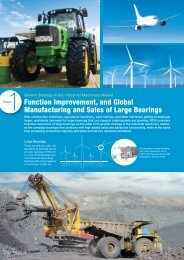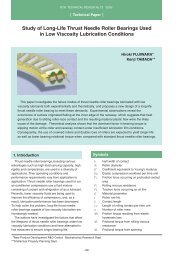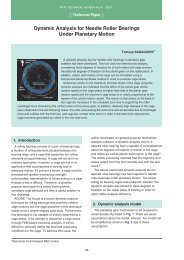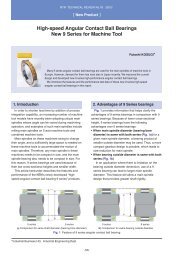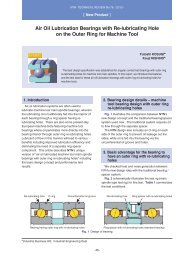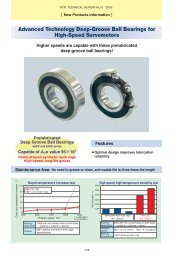Special Issue; Products for Industrial Machinery - NTN
Special Issue; Products for Industrial Machinery - NTN
Special Issue; Products for Industrial Machinery - NTN
Create successful ePaper yourself
Turn your PDF publications into a flip-book with our unique Google optimized e-Paper software.
Development of a New Grease Lubrication System <strong>for</strong> Machine Tool Main Spindles<br />
authors believes that slight increases in the pressure<br />
that follow are due to the gradual shrinking of the<br />
model itself. This pattern is further repeated when the<br />
temperature increases and decreases again due to<br />
the repeated heat cycle.<br />
Thus, existence of the base oil delivery mechanism<br />
described above has been confirmed.<br />
4. Spindle Test<br />
The authors applied their new grease lubrication<br />
system to an angular contact ball bearing that carries<br />
a spindle and executed a running test, simulating<br />
operation with a machine tool. The bearing used was<br />
an angular ball contact bearing with a 100 mm bore<br />
diameter. The technical data <strong>for</strong> the bearing is<br />
summarized in Table 2, and a cross-sectional view of<br />
the bearing is shown in Fig. 8.<br />
Incidentally, the lubricant feed rate adjustment<br />
function provided by the “radial clearance (see Fig. 2)”<br />
in Sec. 3. “Experiment Using a Model Test Rig” is<br />
borne by the “shouldered surface clearance (see Fig.<br />
1)” with actual bearings such as those used in the<br />
authors’ spindle test.<br />
4.1 Temperature increase confirmation test<br />
To investigate the operating characteristics of the<br />
authors’ new grease lubrication system, they<br />
measured the temperature increase on both constant<br />
pressure preloaded bearings and definite position<br />
preloaded bearings. A critical requirement in order <strong>for</strong><br />
the grease lubrication system to be used industrially is<br />
the prevention of a significant increase in bearing<br />
temperature. Fig. 9(a) and 9(b) illustrate spindle test<br />
rigs <strong>for</strong> both preloading systems. In each test rig, two<br />
bearings being tested were arranged in a back-toback<br />
duplex configuration (DB set). The test<br />
conditions used are summarized in Table 3. Among<br />
the test conditions, the axial load value was<br />
determined by considering the maximum allowable<br />
load <strong>for</strong> the contact surface pressure of the rolling<br />
elements. For the definite position preloading test, the<br />
preload was set to the minimum level necessary <strong>for</strong><br />
practical machine tool operation (0 initial clearance on<br />
mounted bearing).<br />
Table. 2 Bearing specifications <strong>for</strong> spindle test<br />
Tested bearing<br />
Contact angle<br />
Rolling element material<br />
Cage material<br />
Prefilled grease in bearing<br />
100 150 24 mm<br />
20˚<br />
Si3N4<br />
Laminated phenol resin<br />
Prefilled Grease-A, 6 g<br />
20˚<br />
(a)<br />
Bearings tested<br />
Schematic construction of test spindle supported<br />
with constant pressure preloaded bearings<br />
24<br />
150<br />
100<br />
(b)<br />
Bearings tested<br />
Schematic construction of test spindle supported<br />
with definite position preloaded bearings<br />
Fig. 8 Section view of test bearing<br />
Fig. 9 Spindle test rig<br />
-13-



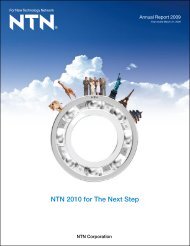
![[New Product] Unit Products for Office Equipment - NTN](https://img.yumpu.com/27154451/1/184x260/new-product-unit-products-for-office-equipment-ntn.jpg?quality=85)
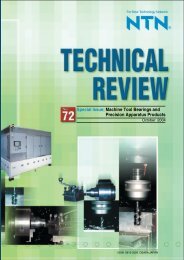
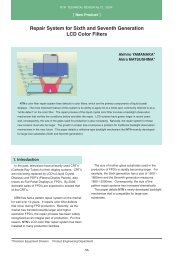
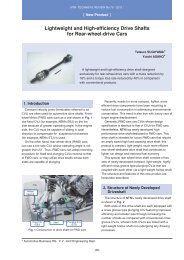
![[New Product] Development of Oil-impregnated Sintered ... - NTN](https://img.yumpu.com/27154427/1/184x260/new-product-development-of-oil-impregnated-sintered-ntn.jpg?quality=85)

